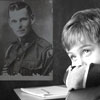Past Lives: The Story Behind The Story
 by Roger Woolger, Ph.D
by Roger Woolger, Ph.D
WHAT ARE PAST LIVES?
If you imagine your psyche as a computer, you can think of past lives as old, corrupted programs that interfere with its running. Like unwanted files you cannot delete, they run over and over in the deepest recesses of your psyche, depleting its resources and making it operate ever more slowly, even to the point of shutdown.
The computer of the psyche is a complex system, with many programs running both close to the surface, at a level we’re aware of, and deeper, at a level that’s invisible to us (much like an operating system such as MS-DOS, which depends on masses of files and code we never see until we hit the wrong key by mistake). We might call the superficial level the personality program and the deeper level the soul program. When problems arise in our day-to-day functioning, they may be the result of mistakes we make in our own running of the program at the personality level—user error, if you will—and such problems are easy to fix. When, for example, we are overanxious about being late or blame ourselves excessively for not being tidy enough, we can usually adjust our behaviors by imposing new habits. But problems at the soul level—such as depression, compulsive cleanliness, or irrational phobias about fire, high places, being robbed, and so on—where patterns from past lives lie embedded deep in our psychic history, can cause the equivalent of a computer’s “fatal error”: severe physical and emotional problems in our present lives and serious karmic consequences for the evolution of the soul.
I confess that I came late in life to computers and, like many of my generation, lack the facility that my children have with them. I hope you’ll forgive the traditionalist in me, who is more at home with terms like “soul” and “unconscious” than with computerese—and, as we go on, I hope you will feel free to translate my terms into your own preferred lingo. Whether we talk of genetic coding or cellular memory, of the psyche’s operating system or the soul’s deep history, the essential point is the same: we are all ruled by forces and powers far larger than we know, and greatest of these is what we may simply call “the past,” a vast psychic pool of prior conditioning that we all share, created by human experience, error, and misdemeanor over millennia. As the philosopher George Santayana succinctly put it, “Those who cannot remember the past are condemned to repeat it”–but when we learn to remember, using past-life recall techniques, we begin to free ourselves from the power of the past.
WHEN THERAPY DOES NOT WORK
Many of the problems that we take to our therapists can readily be traced to childhood—events such as losses, abuse, tragedy, and so on—but there are many issues that years of therapy never seem to touch. So many of my clients arrive with deep feelings of grief or with totally inexplicable phobias—a fear of drowning in a boat when they have never been to sea, for instance—that are totally unaccountable in terms of their present life experience. Over and over again, they will remark that they have had such-and-such a feeling ever since they could remember, or that they have always had fantasies about particular countries, or thoughts about certain unpleasant ways of dying, or else strong convictions of having been a different kind of human being in another era.
Such thoughts are by no means to be dismissed. Indeed, the many accumulated cases of past-life remembering from both therapy and research make an almost indisputable case for discarding the scientific dogma (for dogma it is) of the tabula rasa—the idea that the mind is a “blank slate” at birth. It is slowly dawning on more and more unprejudiced investigators and common readers that most of our troubles arise from issues we were born with, that the soul has its own history. From this perspective, “past-life therapy,” as it has been called for some years, is very much a deep psychology, a psychology of the soul and the deeper tribulations it inherits from the the greater history of humanity. As the great French philosopher Michel de Montaigne wrote in his Essays, “Each man bears the stamp of the whole human condition.”
So when conventional therapy, with its emphasis on our experiences in this life does not work, the reason may be simple: the therapist is looking for the trauma, the event that caused the psychological disturbance, in the wrong place.
WENDY: A MOTHER’S ANXIETY
“I should never have left them alone!”
One of my clients—a mother I will call Wendy—had terrible anxiety attacks every time she saw her children going off to school or even playing with other children away from the house. She could not bear for them to be away from her for very long, even to go to places like summer camp. She knew that this was unfair, and she did her best to overcome her fears. But as her children got older, the irrational fears remained. She was always anxious about them and called them constantly, even when they were adults with families of their own. She came to see me after a friend brought her own young children over for a visit, because the panic attacks had returned to force—only now someone else’s children were triggering Wendy’s deep feelings of dread.
Wendy had tried several therapies over the years, but her anxiety had never really gone away. Naturally, she had explored her childhood, but all she had come up with was a terrifying memory of her mother putting her on the school bus when she was about six. Nothing had happened then to account for the fear; it simply appeared that as a little girl, she had been terrified of leaving her home and her mother.
When we probed more deeply in a regression session, we found that in a past life, Wendy had been a Native American boy. In her reliving of the story, the boy went hunting with his father at age ten or eleven, during a time when the tribe was being driven off its land by white men, and came back home to find the family camp on the riverbank under attack. Emerging from the forest, he saw his mother and his younger brother and sister being raped and killed right before his eyes. He and his father rushed down to try to fend the attackers off with knives and bows and arrows, the young boy courageously throwing himself on them, but the white men with their powerful guns mowed them down. The climactic point of the regression came as the boy died, feeling horribly responsible for the death of his family, even though he and his father were actually powerless. His crying thought was, “I should never have left them alone.”
Once this story surfaced in Wendy’s awareness, it was clear that her childhood fears and her anxiety around her own family had always been unconsciously associated with the Native American boy from the past. Until our session, she had still been afraid that the horror might somehow repeat itself. Just to know that lifetime was an old tape playing in the background of her consciousness was enough to help her erase it and release a great deal of her fear. It sometimes takes further work to break deep habits of fear—but now, at least, Wendy could truthfully tell herself, “My family is safe today. That’s just an old story. I can let it go.”
SEEKING THE STORY BEHIND THE STORY
We know that many people carry patterns of fear, guilt, and obsessive worry like Wendy’s. Clinically, these patterns are labeled “phobias” or “anxiety disorders,” yet the psychiatric literature can rarely pinpoint how they arise. What is most puzzling about such feelings is simply that they are irrational; their content does not make sense in and of itself, and there is nothing to connect the fear to our actual life experience. A man who has never been stabbed or badly cut may have a deep fear of knives; a woman who has never sustained a serious burn may have a terrible fear of fire. Casting about in childhood for explanations of such fears does not seem to dislodge them. Often, as in Wendy’s case, the problem is already present in childhood, fully formed.
From the perspective of past-life therapy, none of this is surprising; the things we fear—fire, drowning, guns, explosions, savage animals, enclosed spaces, crowds, airplane trips—are not childhood traumas at all, but psychically inherited fears, residues of previous lives still carried deeply in the psychic system we call the unconscious or the soul. The horrors we most fear really happened to someone else, but that “someone else” is still in us today, an imprinted memory from a lifetime that is over, even if the past-life personality does not know it.
When we recognize that irrational fear may come from the experience of another lifetime, then we can search for what I call the “story behind the story”–the old tape, like Wendy’s, playing in the background of consciousness. One of Freud’s concepts can help us in this regard: the notion of repetition compulsion, which he defined as an uncontrollable urge to replay old behaviors or stories we are no longer conscious of. When we expand this theory beyond a single lifetime, we can quickly see that a person’s neurotic behavior, though irrational in the present, may make perfect sense in the context of a story from a past life. The woman with the fear of fire may have been burned at the stake; the man terrified of crowds may have been trampled in a riot; the child frightened of loud noises may remember dying on a battlefield; the adult afraid of flying may have been shot down in a past life as a fighter pilot. Every one of these stories has been recorded in many variations in the annals of past-life regression. They show us that every complaint—however irrational it seems when isolated as a symptom—can be a clue to a buried story, the soul’s way of revealing its most deeply held pain.
CHERYL: FEAR OF THE PUBLIC
Residues of a Roman Lifetime
A very common anxiety is the fear of speaking or appearing in front of a lot of people. This crippling condition can come into play even in small groups, as was the case with my student Cheryl, a young professional psychotherapist who attended one of our workshops on Deep Memory Process. Cheryl was a very able therapist, but she had always suffered from crippling panic attacks when it came to speaking out in public. Until the third day of the workshop, she had successfully avoided such anxiety by deliberately burying her nose in her notebook and saying as little as possible. The topic that morning, however, was fear, and when the talk turned to terror in group situations, she found herself having an anxiety attack at the very mention of the subject. She realized that she needed to talk about what was happening to her, and finally she overcame her fear enough to speak out, albeit with her heart beating fiercely, her palms sweating, and her stomach in knots. The transcript that follows is typical of how we can probe for the “story behind the story”–in this instance, the story behind a story from Cheryl’s childhood.
Cheryl: It’s very difficult for me to say this in front of the group, but I had such a strong flashback a moment ago. I saw myself at a Christmas party in this white dress when I was a little girl. All the family was in the room. I can’t go in. I’m terrified. They’re all staring at me. And my shoulder is really hurting.
Roger: Close your eyes and be back at four years old in your little white dress about to go into the room.
Cheryl (trembling, tearful): I can’t. I can’t go in. They’re all looking down at me. I hate this white dress. Why do they want me to wear it? I’m terrified. Something awful is going to happen (she sobs deeply).
Roger (gently helping her focus on the image): Move forward into the room. Go through it. It can’t hurt you today.
Cheryl: I’m totally frozen. I’m in the room and they’re all saying, “What a nice dress. How lovely.” I can’t look at them. I’m so ashamed and terrified.
Roger: What happens?
Cheryl: Nothing. I feel better somehow. It’s not about them. It was that door, the dress.
Roger: Go back again to the most frightening moment, just before you go through the door. That’s right. Stay with the fear. Breathe into it. Let the worst image of something awful surface on a count of three. One, two, three!
Cheryl (almost shrieking): Oh, help me, it’s a huge crowd. They’re screaming at me from above. I’m a grown woman in a white dress. It’s Rome. They’re going to kill us. Ah! A lion! My arm! I’m not there anymore. I’m above it all looking down. (She has grabbed her arm and bent over in pain. She sobs, then the pain starts to subside and she feels relieved. After many minutes of sobbing, she is finally able to speak.) I saw myself as an early Christian. That was a Roman arena. No wonder I hate white dresses and noisy groups. Thank God that’s over.
At the deepest layer of Cheryl’s fear, her unconscious mind associated public exposure with a humiliating death. Looking back, we can see that there were several “triggers” here for her. One was being in front of a group—the training group and, earlier, her family. That was the first layer of the story. The second trigger was people looking at her from above, because in the Roman arenas, as we know, the crowd looked down upon the grisly spectacle. The third trigger was the white dress.
What is striking here is that Cheryl’s terror initially seemed to arise, as conventional therapy would predict, from a childhood event. Yet remembering her childhood did not reveal the cause of the irrational fear; it merely provided an early example of how the fear was triggered. Clearly, Cheryl’s fear of groups came with her at birth lying dormant until certain situations, like the Christmas party, aroused it. Many of our fears work this way. But there is always a deeper story that will reveal the reason for the soul’s debilitating reaction, and when we relive the story, we remove its emotional charge, like a deeply embedded psychic splinter that has always been sensitive when the area around it is touched.
There was another important element in Cheryl’s regression experience: the intense shoulder pain, which actually cleared. Such pains are completely healed after regression.
PETER: AN ADOLESCENT’S DEATH WISH
“I’m not going to live very long.”
Not all regression journeys need to unpeel a childhood layer of trauma, and not all our stories are about fear. Some problems may lie dormant through childhood, only to be triggered in adolescence or much later in life. My last example of a “story behind the story” is of an angry, disturbed adolescent I will call Peter.
Around the age of seventeen, Peter became very rebellious toward his parents, his teachers, and pretty much anyone around. Familiar adolescent “acting out,” we might call it. He got into fights in bars, he drank too much, and when he could get hold of a car, he drove too fast. He actually had a couple of bad motorcycle accidents. To observers, it looked as if he were trying to kill himself. He would probably have denied this; it wasn’t at all conscious. But when we probed for the story behind the story, we discovered that he was unconsciously reliving a story in which he was indeed killed. He found himself in a past life as a raw military recruit, pressed into service in the British army. He had been brutalized, sodomized by his superiors, and used as cannon fodder in a horrible battle somewhere in Europe.
In a regression, Peter saw himself as the young soldier, bleeding to death from massive wounds, abandoned to die on the field of the dead. “It’s not fair,” he groaned. “Why did this happen to me? I never got to live at all. I could have been married, had some kids, run my own little shop somewhere. I hate them, the bastards! Their stupid, meaningless wars. They just use us. They don’t give a shit for anything but their own glory. Filthy hypocrites! All that crap about doing it for ‘the country.’ It’s all one big lie!” He could not let go of his hatred and disillusionment with everything the war, and particularly the leaders, stood for. These hugely resentful thoughts became deeply mixed up with all the terror and violence he carried, both in himself and from all the chaos around him as he died. In his despair, the dying soldier took with him the devastating thought that “This world is dangerous and I’m not going to live very long.”
This story didn’t surface until Peter was an adolescent simply because it had to do with adolescence. In the past life that he was carrying, he had in fact died at around seventeen. All the mindless “acting out” he was doing in the present was a direct consequence of this painfully unfinished past-life story, one that has recurred in my case notes over and over again in numerous variations. But bringing the “story behind the story” to consciousness was a huge relief for Peter. He could now see what was driving him and how he had been living in irrational—but explainable—rage and despair that his life was about to end. He quickly dropped all his self-destructive behaviors and went on to channel his powerful adolescent energies into playing sports and getting into college—both of which he did with great success.
Excerpt from Healing Your Past Lives
Posted in Past Life Therapy, Reincarnationwith comments disabled.





